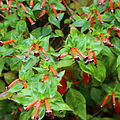| Cuphea ignea | |
|---|---|
 | |
| Scientific classification | |
| Kingdom: | Plantae |
| Clade: | Tracheophytes |
| Clade: | Angiosperms |
| Clade: | Eudicots |
| Clade: | Rosids |
| Order: | Myrtales |
| Family: | Lythraceae |
| Genus: | Cuphea |
| Species: | C. ignea |
| Binomial name | |
| Cuphea ignea | |
Cuphea ignea, the cigar plant, cigar flower, [2] firecracker plant, or Mexican cigar, sometimes referred to as cigarette plant or cigarette bush is a species of flowering plant in the genus Cuphea of the family Lythraceae. It is a tropical, densely branched evergreen subshrub. [3] This species, native to Mexico and the West Indies, produces small, tubular, bright red to orange flowers. [4] Each flower is tipped with a thin white rim and two small purple-black petals. The flowers, which are attractive to hummingbirds and butterflies, [5] resemble lit cigars, hence the name ignea, which is Latin for "fiery". [6] The genus name Cuphea comes from the Greek word kyphos which means curved or humped; this is thought to refer to the shape of the seeds. [4] The leaves are small, elliptical and of a bright green colour. It grows to about 60 cm (24 in). [7]



